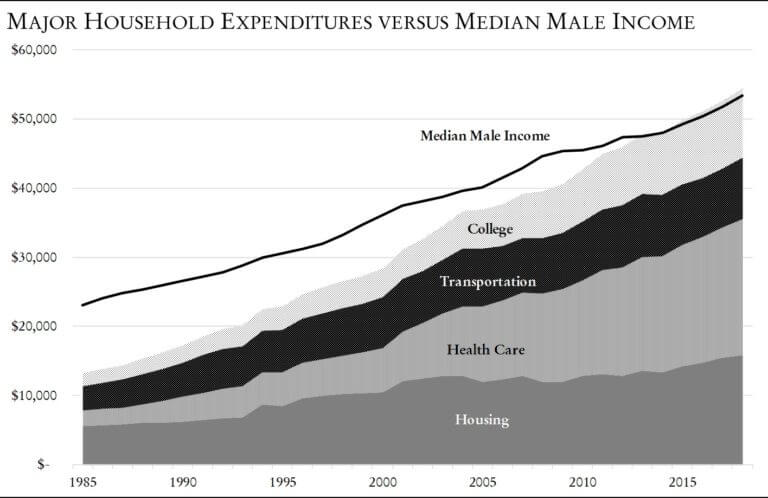Advice for Employers and Recruiters
Why are students demanding paid internships and higher wages for entry-level jobs?
A week doesn’t go by without an employer that College Recruiter works with or who I’m connected with in some way questioning why students aren’t interested in their unpaid internships, or their entry-level jobs that pay $12.00 an hour. Invariably, the conversation includes the phrase, “back in my day”.
The reason, quite simply, is that the 99 percent of students who weren’t fortunate enough to be born into wealth simply need the money to eat, pay rent, and afford other necessities. Yes, I get that when you went to school in 1979 that you worked hard (and part-time) as a waiter and paid for your own college and living expenses and graduated with no debt. But do you get that the same job now pays only a fraction of what it did four decades ago and the cost of housing, health care, transportation, and college are exponentially larger than they were when Carter was still president?
According to the Bureau of Labor Statistics Consumer Price Index (CPI) and the Bureau of Economic Analysis’s Personal Consumption Expenditures Price Index (PCE), a student working as a part-time waiter today needs to earn $34.20 an hour based on a 30-hour workweek in order to have the same spending power as you did in 1979 if you were making about $10 per hour. As eyebrow-raising as that may be, the reality is actually worse.
Using the CPI and PCE essentially assumes that what someone would buy in 2020 is the same as what a similarly situated person would buy in 1979. But spending habits, like our tastes in fashion, change. If you attended the University of Minnesota (go Gophers!) in 1979 and your lifestyle was that of an average student, the $10 per hour you made in wages plus tips might have been sufficient to cover your costs. But an average student today lives in a nicer apartment, has to cover more of their healthcare costs, is more likely to use cars as their primary means of transportation because mass transit hasn’t kept up with the growth of the Twin Cities metro, and college, well, don’t even get me started (yet) on the horrendously increased cost of college.
Now, I can hear some objections. “But I was poor and didn’t have all the luxuries these pampered kids have today! They’re choosing to go expensive schools and have fancy toys. That’s their problem!” Well, to an extent, that’s true. But before you starting point fingers like that, maybe look first into the mirror. What kind of a television did you have when you were in college? Did you have friends over to play videogames or watch a movie? If so, your TV was probably at least as good as those owned by your friends. Now, picture using that same TV today to watch anything. Hard to imagine, isn’t it? Would you think it reasonable to expect any of today’s students who are living the lifestyle you lived decades ago to use the same TV you did? Of course not. If your TV was even average as compared to those of your friends then, logically, you should agree that today’s student should have a TV that is average amongst their friends. And that means a large (but not enormous), flatscreen TV. At Best Buy, best selling televisions averaged $330 in 1994 and $280 today, so that appears to be a deflation of $50. But when you factor in inflation, they’re about the same price. So don’t start thinking that today’s student with a flatscreen TV is living the life of luxury, as they’re no more living that lifestyle than you were a few decades ago.
Prefer numbers instead of TV analogies? Let’s flashback to the era when Gen Xers like me were graduating from college. Let’s assume that you graduated in 1985 and so you’re about 52 years of age now. In that era, the median male worker needed only 30 weeks of income to afford a house, car, healthcare, and education. Some call this the Cost-of-Thriving Index (COTI). By 2018, that same lifestyle would require 52 weeks of income, an increased workload of 73 percent.
If we look at median expenses for male workers today (we use male because households with multiple people still tend to have more males working than females) and compare those expenses to those in 1985 for people with similar, average lifestyles, we find that the male worker in 1985 could easily afford housing, healthcare, transportation, and college costs, meaning they had plenty of room leftover for non-core items like clothing and even some discretionary items like entertainment. Today? That same lifestyle leaves the male short of cash even before non-core and discretionary items. Instead of it taking 30 weeks to cover all of these COTI costs in 1985, it takes 53 weeks to cover the equivalent costs in 2018.

So, the next time a younger Millennial or Gen Z worker passed on your unpaid internship or questions the $12.00 starting wage for your entry-level opportunity, maybe choose to advocate within your organization for higher wages. In other words, instead of pointing fingers, have a look in the mirror. The problem isn’t with the person you’re pointing at but, instead, with the person whose reflection is in the mirror.
New Job Postings
Advanced Search